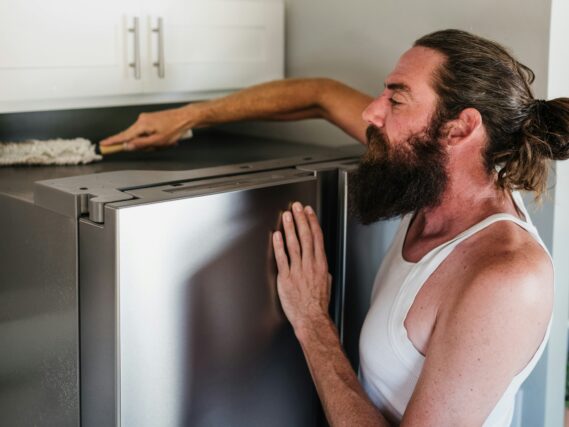Is Your Home Making You Sick? The Top Hidden Dangers to Watch Out For
 Unsplash
Unsplash Your home should be your sanctuary, but lurking dangers can sometimes compromise your health. It’s not just about obvious hazards like slippery floors or loose cords. Often, the culprits are invisible, hiding in plain sight. These seemingly harmless aspects of your home could be subtly sabotaging your well-being. Here’s what to watch out for.
1. Dust mites: Invisible critters thriving in your cozy bedding
Dust mites are microscopic creatures that feast on dead skin cells, making your bed their all-you-can-eat buffet. Their droppings can trigger allergy symptoms, eczema flare-ups, and even asthma attacks. Regularly washing bedding in hot water and using allergen-proof mattress and pillowcases are essential, especially for those with sensitivities.
2. Mold and mildew lurking in damp spots
Hidden leaks behind walls, poorly ventilated bathrooms, or even perpetually damp laundry create the perfect environment for mold to thrive. Exposure can cause respiratory problems, headaches, and skin irritation, especially for those with allergies or compromised immune systems. Identify any moisture issues and treat them immediately.
3. Toxic chemicals in cleaning products
Ironically, those products meant to keep your home clean might be polluting your air. Many conventional cleaners contain harsh chemicals that off-gas into the air, irritating your lungs and eyes. Opt for natural alternatives or look for products with “fragrance-free” or “low-VOC” labels.
4. Lead paint in older homes
Homes built before 1978 might still contain lead paint. If it’s chipping or deteriorating, lead dust can contaminate your living space. Lead exposure is extremely dangerous, especially for children, leading to developmental issues, cognitive impairment, and other serious health problems. Have older homes tested and get professional remediation if needed.
5. Radon: The odorless, colorless, radioactive gas seeping from the ground
Radon gas occurs naturally as certain rocks break down, and it can enter your home through cracks in the foundation. Radon is the second leading cause of lung cancer, and the only way to detect its presence is through testing. Home test kits are readily available and can alert you to potentially dangerous levels of exposure.
6. Clutter creating stress and anxiety you don’t even realize
While not a physical toxin, excess clutter has a surprisingly negative impact on your well-being. A visually chaotic environment overloads your brain, contributes to feelings of overwhelm, and makes it harder to relax. Even if you think you’ve gotten used to it, clutter subtly chips away at your peace of mind.
7. Poor indoor air quality leading to headaches, fatigue, and allergies
Dust, pollen, pet dander, mold spores, and off-gassing from furniture and building materials all contribute to poor indoor air quality. This can exacerbate respiratory issues, worsen allergy symptoms, and cause general discomfort. Boost ventilation, consider an air purifier, and reduce sources of indoor pollution whenever possible.
8. Carbon monoxide: The silent killer you can’t see or smell
Carbon monoxide (CO) is a colorless, odorless gas produced by faulty furnaces, water heaters, or gas stoves. Exposure can cause flu-like symptoms, headaches, and dizziness, but it can be fatal in high concentrations. Install CO detectors on every level of your home and have fuel-burning appliances professionally inspected regularly.
9. “New” smells from furniture, carpets, and building materials off-gassing VOCs
That “new car smell” isn’t harmless! New furniture, carpets, paint, and even some electronics release volatile organic compounds (VOCs) into the air. These chemicals can cause headaches, respiratory irritation, and long-term exposure is linked to more serious health issues. Ventilate well after bringing new items into your home and opt for products with low-VOC labels whenever possible.
10. Harsh lighting harming your sleep and mood
Bright, blue-spectrum lights suppress melatonin, the sleep hormone, and disrupt your circadian rhythm. Avoid overhead lighting and harsh LED bulbs in the hours before bed and opt for warmer, softer light sources to signal to your body that it’s time to unwind.
11. Electromagnetic field (EMF) exposure from electronics disrupting your well-being
While the jury is still out on the long-term health effects of EMF exposure, some studies suggest it can disrupt sleep, contribute to headaches, and even increase the risk of certain health problems. It’s wise to minimize unnecessary exposure, especially in your bedroom. Turn off your WiFi router at night, keep your phone away from your bed, and unplug electronics you’re not using.
12. Dry air wreaking havoc on your skin, eyes, and sinuses
Particularly during winter months, low humidity can irritate your nasal passages, dry out your skin, make you more susceptible to colds, and worsen allergy symptoms. Use a humidifier, especially in your bedroom, to add moisture back into the air and improve your overall comfort level.
13. Noise pollution disrupting your sleep and increasing stress levels
Constant background noise from traffic, neighbors, or even noisy appliances can take a toll on your well-being, even if you’ve become accustomed to it. Chronic noise exposure raises stress hormones, disrupts sleep, and can contribute to anxiety and irritability. Use white noise machines, earplugs, blackout curtains, or even strategically placed furniture to mitigate unwanted noise.
14. Allergens in your favorite houseplants triggering reactions
While plants purify the air and add a touch of nature, some trigger allergies more than others. Weeping figs, ferns, and certain types of palms can release pollen and spores that cause sniffling and irritation. If you notice your symptoms flaring up, research low-allergen indoor plants and consider replacing those triggering your reactions.





